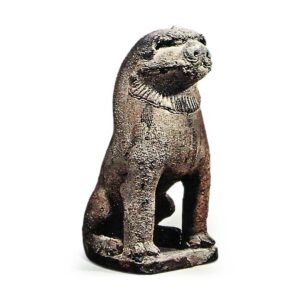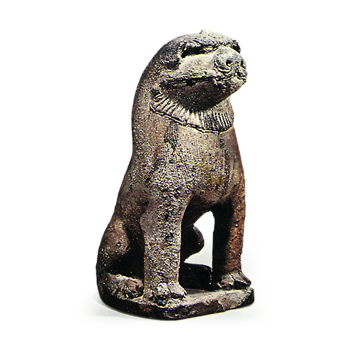
Komainu are lion-shaped figures made of copper, stone, pottery, wood, or other materials and placed on either side of the shrine’s worship hall. Komainu were also placed at the foot of the “noren” (bamboo blind) in the Seiryouden.
The majority of ceramic guardian dogs seem to belong to the Seto lineage, the most representative of which is the guardian dog by Tojo Fujishiro, an important cultural property in the collection of Fukagawa Shrine in Seto City. According to legend, Fujishiro prayed at Fukagawa Shrine and obtained clay from his grandmother’s bosom, and feeling a sense of divine virtue, he personally made and dedicated a pair of guardian dogs. The female dog was lost during the Middle Ages, and the existing male dog is not in perfect shape due to the damage to its legs. The right forelimb is broken from the middle, and the left is completely missing and has been repaired with a piece of wood. The rear ankles are also missing on both sides, the center corner of the head is missing, and the tips of both ears are also missing. The height is 52 cm. The glaze is yellowish with a hint of amber, and the clay is grayish, as if the piece were made of porcelain. The glaze has an amber-like appearance, and in some places there are raw, fine cracks in the glaze, similar to those found on wares excavated from the Tsubaki kiln. The mane has a comb-like pattern, and the use of the mane is very powerful, giving it a simple yet dignified appearance, as if it were alive. In the Seto region, ceramic guardian dogs were often made throughout the ages, and most of the guardian dogs at shrines in the region are made of ceramic.



